Red Witch Ruby Fuzz, Violet Delay, Scarlett Overdrive, and Eve Tremolo Reviews
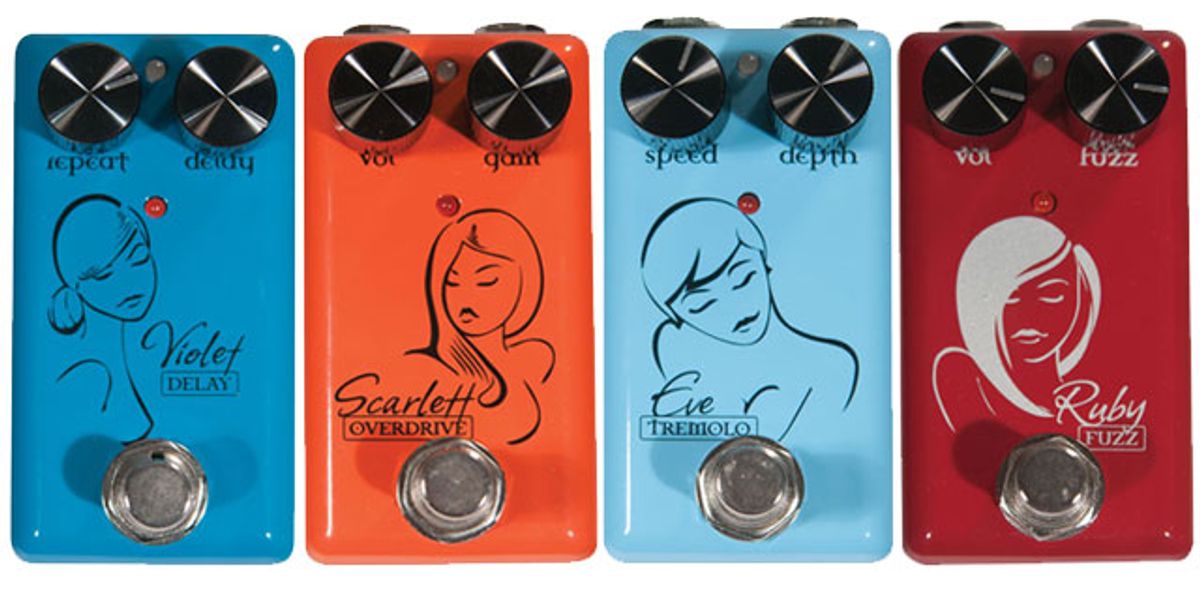
Here we check out the Ruby Fuzz, Violet Delay, and Scarlett Overdrive.
We’re used to guitar-gear inventors and engineers touting their wares and peppering their pitch with words like revolutionary, innovative, and groundbreaking. Unfortunately few of those promises lead to products that actually improve our experience as players.
Not all of these mad-scientists-with soldering irons are hoax peddlers, however. With the introduction of the lithium-ion powered, rechargeable Seven Sisters line of effects, Ben Fulton of Red Witch Pedals may be able to count himself among the tinkerers who have opened up new options for the gigging guitarist in a real way. And given what these little pedals could mean for the player on the go—or even players who rarely leave the house but have little dedicated space for their gear—Red Witch may be on the brink of changing up the stompbox market in a significant way. Here we check out the Ruby Fuzz, Violet Delay, and Scarlett Overdrive.
More Like the Seven Dwarves
Red Witch is well known among pedal
fiends as a builder of top-notch analog
effects. But the Seven Sisters represents
thinking beyond tried-and-true templates
for success. All of the Seven Sisters are
housed in just about the tiniest metal
enclosures I’ve ever seen. We’re talking
miniscule here—a little bit bigger than
a standard size matchbook and about
an inch tall. Small size doesn’t come at
the expense of style, though. Each pedal
is painted with a high-gloss finish and
adorned with a likeness of each pedal’s
namesake rendered in a minimalist, almost
Japanese line-drawn style. In fact, they
wouldn’t look out of place as a high-fashion
accessory.
Each Sister has two knobs for adjusting tone parameters as well as a sturdy true-bypass switch. To make their presence even less cumbersome the input and output jacks are located at the top end of the box. If you were to purchase the entire series and string them together, your pedalboard would be less than a foot long.
Sometimes smaller pedals can get a little squirrely underfoot. So thoughtfully, Red Witch ships every Sister with textured rubber feet and a precut Velcro strip to affix to the bottom of the effect.
Small size isn’t all that makes the Seven Sisters special, of course. Red Witch claims to be the first company to put lithium-ion batteries inside an effects pedal. What’s so cool about having a smart-phone battery in a guitar effect? For starters, they’re rechargeable, which means freedom from unreliable power sources, tangles of wire, and noise from shoddy club wiring. Just grab a 9V DC power supply and plug it into the left-hand power socket for four hours (12 hours the first time) and you’ve got one to two weeks of power before recharging again. An LED mounted on the top of the box helps you monitor the charge capacity. The company says the cells last about two years, and replacements can be purchased at authorized Red Witch dealers.
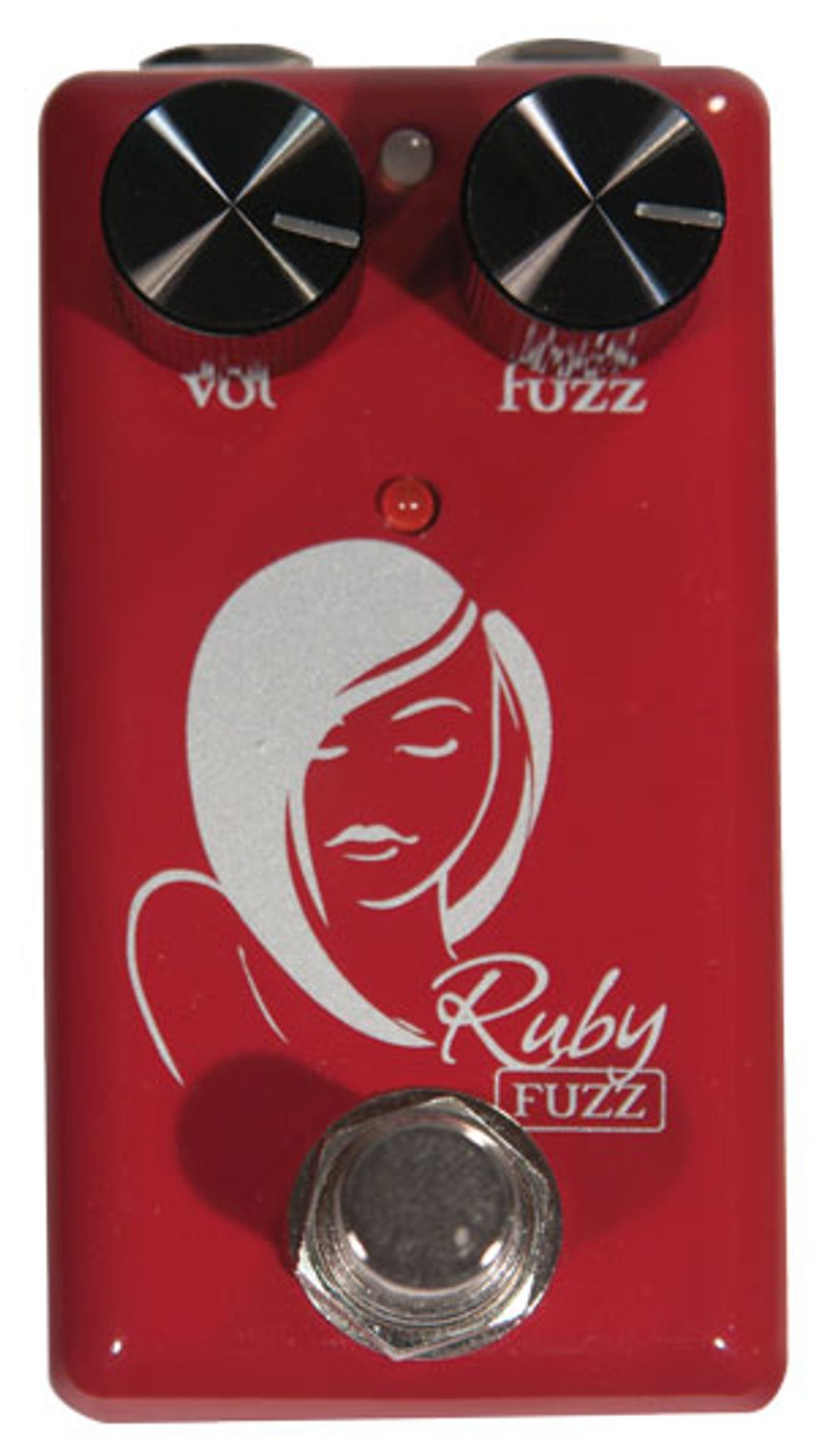
Ruby Fuzz
I tested the Ruby Fuzz, Violet Delay, and
Scarlett Overdrive with a Vox Pathfinder,
a ’68 Fender Bassman powering a 4x12
with Celestion Vintage 30s, and a Gibson
Les Paul and Fender Stratocaster. And the
Ruby Fuzz was my first up.
The artwork on the Ruby suggests that she’s the most serene and shy of the Seven Sisters, but that’s a total put-on. With the Volume and Fuzz knobs at about 75 percent, I couldn’t help but think of Seattle, circa 1992 (and Ruby in a pair of Doc Martin’s and ripped fishnets with some chipped-up nail polish). Ruby can create a very thick wall of fuzz and burning sustain that doesn’t get too raunchy. The general character is quite close to a Big Muff, but without the rotund and flabbier qualities that some players associate with that type of fuzz. Instead, Ruby’s tone is quite focused and clearer in the midrange.
The Fuzz control is remarkably responsive. Halfway up you can get a very hot overdrive tone that compliments the 6L6-powered Bassman’s lower clean settings. Or you can push the Fuzz to its maximum setting and then roll off your guitar’s volume for a weighty growl. I found some of my favorite tones with the Fuzz around 80 percent, which gives the Bassman a very aggressive bite and a capacity for sharp, defined harmonics—perfectly suited for a rhythm or lead tone, and particularly with the Les Paul.
You could make a case that the Volume control could use a little more firepower. Most of my time with Ruby was spent with the Volume control in the upper reaches to achieve unity gain with the Bassman. This isn’t necessarily a flaw, depending on how you employ a fuzz box. And if it makes Ruby less than the best way to get an aggressive volume bump on top of your fuzz, it does nothing to diminish Ruby’s capabilities as a texturizing tool. You just may need the help of a boost pedal (check out Sister Lily) if you’re looking to really cut through a loud band mix.
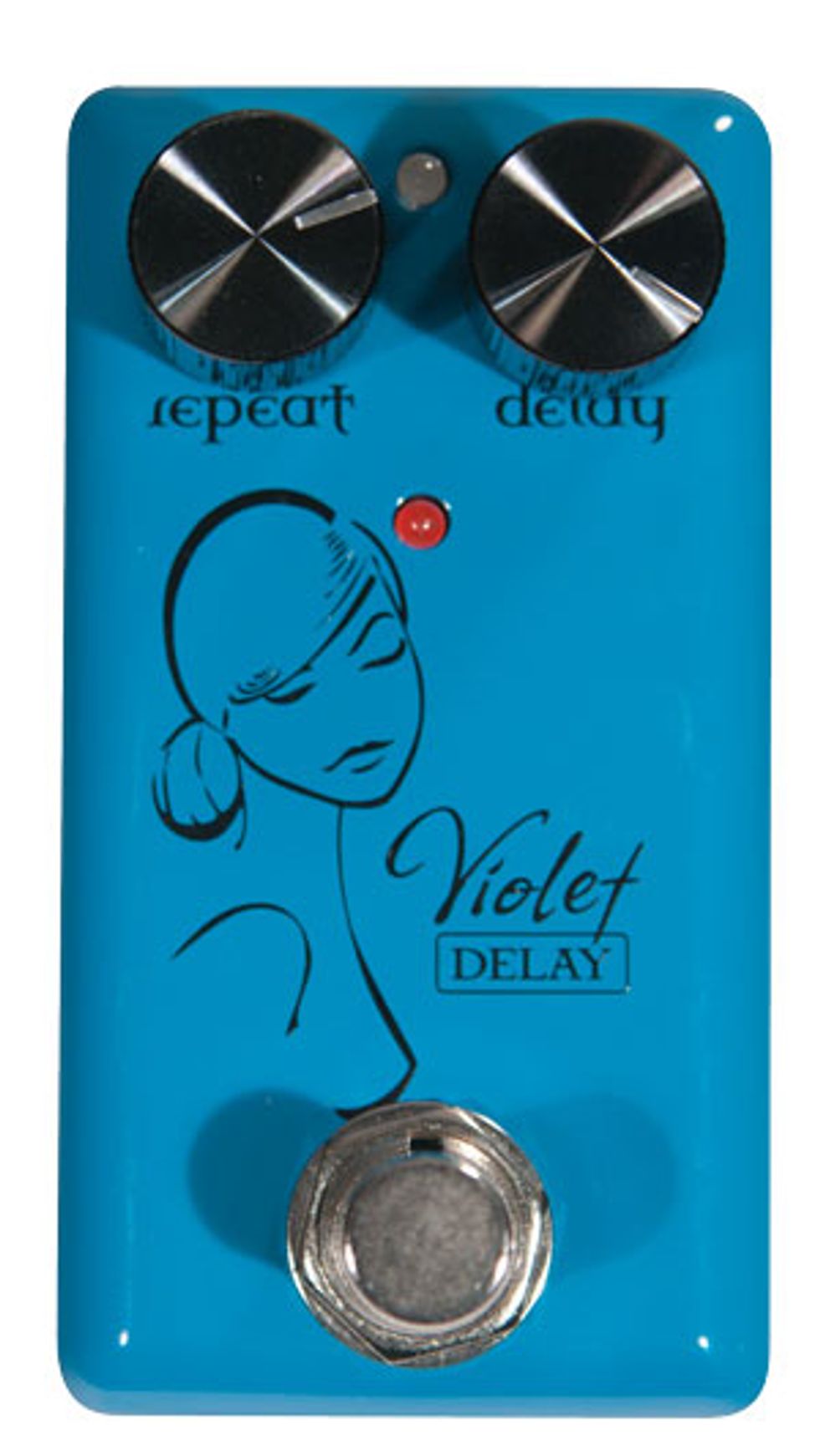
Violet Delay
Violet is a big sounding delay for having
such a dainty frame. There’s 800 ms of
delay available—impressive for an analog
delay, which often maxes out at about
600 ms. It also has a very balanced voice
complete with a touch of analog darkness
and a clarity that keeps things from getting
too shadowy.
With Delay turned all the way counterclockwise, you get the full 800 ms experience. At the lowest Repeat setting, you’re looking at 6 to 7 repetitions of your original note. At the highest, repeats seem almost infinite and will self-oscillate. As with most analog delays, turning both the Repeat and Delay in conjunction can yield some very impressive delay warbles and washes that are great for experimental soundscapes and cool intros and outros. Rockabilly and surf fanatics will find a very useful slapback setting by dialing the delay to about 75 percent or higher, and keeping the Repeat turned down low.
Violet does make one sacrifice in the cause of being compact. The wet/dry blend control is located inside the box in the form of a pot that you access by removing the four back-plate screws. The unit ships with a 40 percent wet/60 percent dry setting, but if you love to tinker with tone, you’ll probably find yourself tweaking the Blend pretty quickly. I found the stock setting offered a cool, well-rounded flavor for the Stratocaster and its single-coils. The Les Paul benefitted from a wetter signal, however.
In the end, the Blend knob isn’t a huge issue, especially given the other advantages of a very un-huge delay unit and that the alternative is a cluttered control set. If your sets are built around songs that have wildly varied delay blends from tune to tune, Violet won’t be the best option, but Violet excels in both it’s simplicity, ease of operation, and the colorful breadth of delay sounds you’ll get.
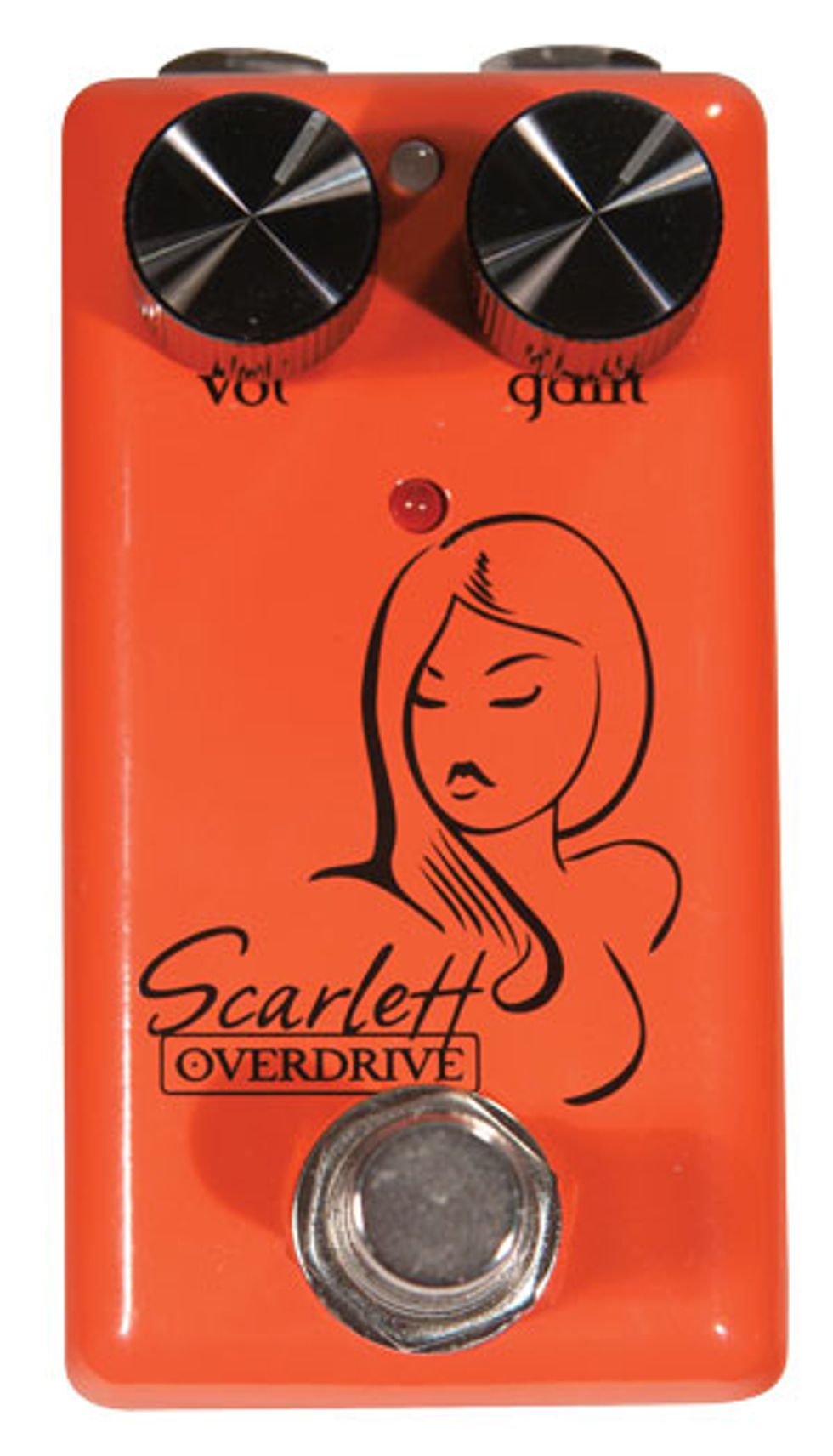
Scarlett Overdrive
Scarlett is the sienna-tinged overdrive Sister.
And while ostensibly the tamest of the three
dirtboxes in the series, Scarlett has the capacity
for a guttural bark when you need it.
With the Volume at 75 percent and a Les Paul driving the signal, Scarlett matched the volume of the Fender Bassman’s clean tone. And with the Gain setting at about 10 percent I got a sweet smooth break-up with nice harmonic glow. These lower settings are great for pushing amps over the edge into warm tube crunch for leads. Scarlett’s output doesn’t smother the original tone of the guitar, either, though there is a midrange emphasis that’s common to many ODs. Rolling up the Gain to 50 percent gave riffs a truculent swagger and a smoky, whisky-soaked voice. Pushing her up to full Gain sounds like an all-out bar fight complete with razor-blade trebles and a heavy low end. Even at this extreme setting you don’t really have a distorted sound, though—more of a true-to-form Hammer of the Gods, big-amp tone. It seems Scarlett stopped listening to rock in 1979 and has some very classic tendencies to show for it.
Like Violet, Scarlett has an adjustable pot inside the enclosure and a clockwise rotation produces less treble and gain. The stock setting was fine with the Les Paul, but proved a little piercing for my taste with singlecoils. A slight clockwise twist on the pot fixed this right up. I would expect having to access this adjustor to be less of an issue than with the Violet delay, as many players will maintain a congruent tone with their crunch setting or work with the amp’s EQ to accommodate different pickups.
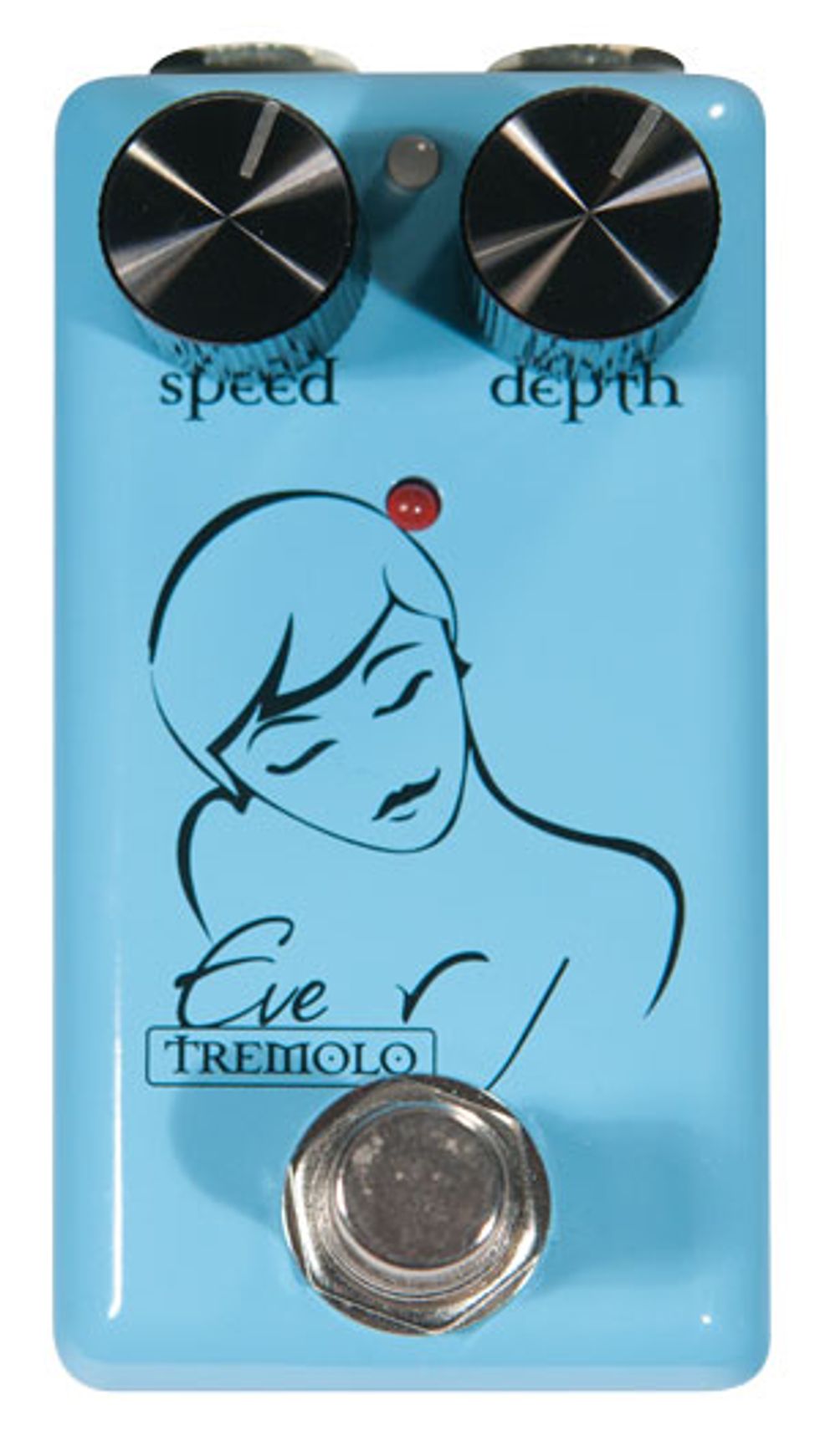
Eve Tremolo
The baby blue Eve tremolo is capable of very
lazy, liquid output. Compared to the deep
throb of a Fender Twin Reverb, Eve’s tremolo
tends to be a bit brighter. However, the analog
circuitry keeps Eve surfing safely away
from tinny, watered-down waves that you
might hear in digital trems. When the Speed
control is swept completely counter-clockwise
you can get a pretty choppy tremolo without
the signal turning into monotone buzz.
Bringing the Speed down (clockwise) delivers a cool Ventures-style warble. These slow settings work beautifully with the equally responsive Depth knob. At the 3 o’clock position it will give your tone the faint undulating motion. Turn it all the way up and you’ll have a saturated, intense pulse.
A small trim pot mounted on the silicon board enables adjustments to Eve’s gain. The unit ships at unity, but a full counterclockwise turn adds enough gain to overdrive the Bassman I tested it with. Extreme settings won’t be for most tastes, but it’s a very cool option that is lacking on many onboard tremolo circuits and stompbox trems. And it’s great for textured spectacle or machine gun leads.
The Verdict
The Seven Sisters pedals are a pioneering
innovation, and Fulton probably deserves
a Boy Scout medal for the work he’s done
here. The Sisters’ small size means they’ll
find homes on cluttered boards, and they’re
great for players who need an extra flavor
without taking up too much space. Any gear
freak can always find another 1 1/2" spot to
jam in one of these gems, especially if they’ll
last two weeks on the road before a recharge.
Getting these pedals through the airport for
a fly-in gig will be a breeze—no more bulky
ATA flight cases for those one-off shows.
And a retail price of $129 per unit isn’t
all that bad for an analog effect with truebypass
and notably solid construction. With
normal upkeep and attention, it’s a fair bet
these Sisters will age well and remain active
on the pedalboards of gigging musicians for
many years to come.
Buy if...
you need a compact, portable effects solution that doesn’t sacrifice tone.Skip if...
your Big Bird feet can’t handle close quarters.Rating...
Ruby Fuzz
Violet Delay
Scarlett Overdrive
Eve Tremolo

